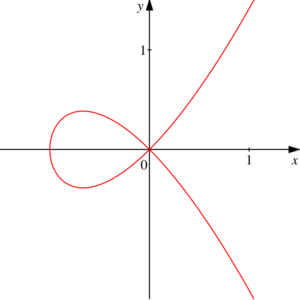Crunode
 From HandWiki - Reading time: 2 min
From HandWiki - Reading time: 2 min
In mathematics, a crunode (archaic) or node is a point where a curve intersects itself so that both branches of the curve have distinct tangent lines at the point of intersection. A crunode is also known as an ordinary double point.[1]
For a plane curve, defined as the locus of points f (x, y) = 0, where f (x, y) is a smooth function of variables x and y ranging over the real numbers, a crunode of the curve is a singularity of the function f, where both partial derivatives [math]\displaystyle{ \tfrac{\partial f}{\partial x} }[/math] and [math]\displaystyle{ \tfrac{\partial f}{\partial y} }[/math] vanish. Further the Hessian matrix of second derivatives will have both positive and negative eigenvalues.
See also
References
- ↑ Weisstein, Eric W.. "Crunode". Mathworld. http://mathworld.wolfram.com/Crunode.html. Retrieved 14 January 2014.
es:Punto singular de una curva#Crunodos
 |
 KSF
KSF
